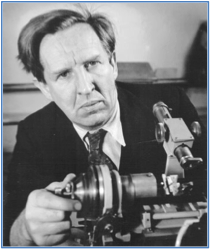News
John Desmond Bernal
Posted by: Joachim Frank |
January 11, 2017 |
No comment
 In Tallahassee, Florida, I had the privilege to participate in the 90th birthday celebration for Don Caspar, as I will report in another note. Andrew Brown, the last speaker of that Symposium organized at Florida State University gave a historical account of J D Bernal, a physicist who crossed paths with Don early on and must have been quite influential for his thinking.
In Tallahassee, Florida, I had the privilege to participate in the 90th birthday celebration for Don Caspar, as I will report in another note. Andrew Brown, the last speaker of that Symposium organized at Florida State University gave a historical account of J D Bernal, a physicist who crossed paths with Don early on and must have been quite influential for his thinking.
Now what interested me greatly is that Bernal, as early as 1931, well before the discovery of the structure of DNA (1953 by James Watson and Francis Crick), well before the structure of any protein was known (1958 — myoglobin by John Kendrew and Max Perutz), and well before the Central Dogma of molecular biology was formulated (1958 by Francis Crick) considered the problem of replication of a protein based on first principles, and excluded the possibility of replication in 3D and 2D, leaving only 1D. The lecture that Bernal gave in 1931 (and here is only part of it!) was never published, and it is now found in historical archives. (Int. Congr. of the History of Science, June–July 1931 A4×7 Box 22 of the Bernal papers.)
I’m reproducing the text below from a note published by Andrew Brown and Alan MacKay , Birbeck College, London (“J D Bernal and the replication of the genetic material – hindsight on foresight” J. Biosci. 30(4), September 2005). Andrew Bown also wrote a book on Bernal (J. D. Bernal: The Sage of Science, Oxford University Press: 2005), which was reviewed by Ken Holmes (http://www.nature.com/nature/journal/v440/n7081/full/440149a.html).
–Joachim Frank
“We are beginning to grasp the chemical and physical nature of the protein molecule” . . .
“The facts of genetics demand, as JBS Haldane has pointed out, that, at some stage in mitosis, the individual molecules in a chromosome must be exactly duplicated. A complete molecule can be duplicated in three ways. If it is solid and 3-D only a supernatural agency, a divine copyist, can, entering its inner complexity, reproduce it in detail. If we prefer a natural solution, we must imagine the molecule stretched out either in a plane or along a line. In either case the simpler constituent molecules have only to arrange themselves one by one on their identical partners in the original molecule, and then become linked to each other by the absorption of suitable quanta from radiation or from second order collisions. That such autocatalysis is possible is indicated by recent work in Russia and America, where the regular atomic arrays of metallic catalysts are shown to operate like laceworker’s frames6 on which simple organic molecules settle to be joined into larger aggregates. A 2-D reproduction of this kind is impossible, owing to the fact that the constituent amino acids in nature are not symmetrical, but exist in right or left hand forms. 2-D reproduction would lead to mirror image molecules, which are not found in nature. There remains then only 1-D reproduction. At the moment of reproduction, but not necessarily at any other time, the molecule of the protein must be imagined as a pseudo-linear, associating itself, element by element, with identical groups, related by an axis instead of a plane of symmetry, and thus preserving only right – or only left-handed symmetry (ital. by JF).. This hypothesis is clearly indicated by Astbury’s explanation of Svedberg’s numbers. Svedberg has established that most natural proteins consist of M. Wt. 34,000 or multiples 2, 3, or 6 times that number. This gives us the confidence to treat all protein molecules, regardless of their complex constitution, as belonging to one natural species.”
“It is impossible to claim these that these ideas are anything but preliminary guesses, but they have the advantage of being susceptible to experimental test”.



